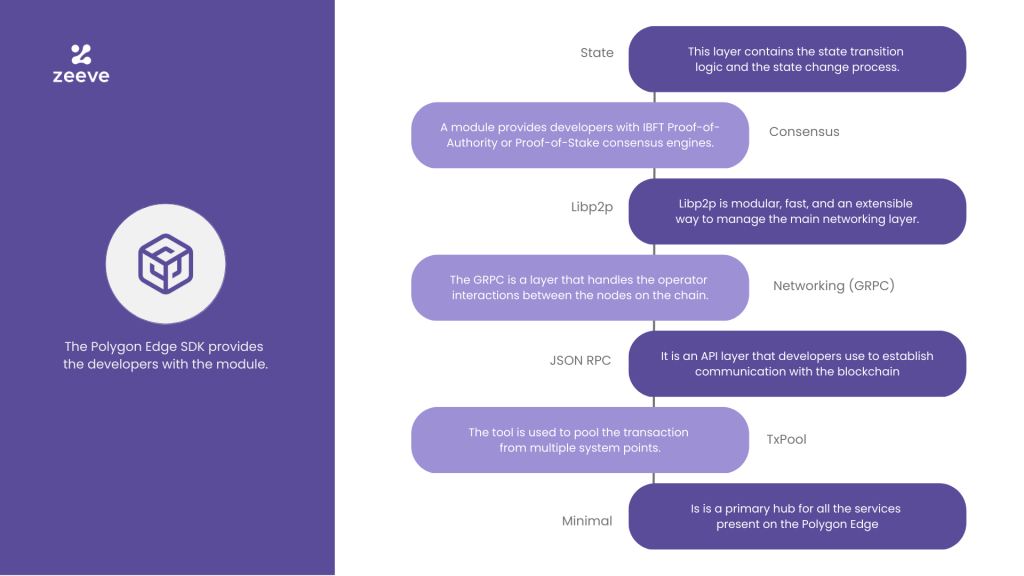Blockchain is changing the industries’ way of work and providing them with the utmost security in a decentralized environment. However, even in 2023, the issue of scalability remains one of the biggest challenges. In 2017 came Polygon, a blockchain stack to handle transactions on the Ethereum Network
Polygon is a cutting-edge framework representing a new generation of blockchains known for scaling on Ethereum. Polygon does this by working on the Proof of Stake consensus mechanism. Polygon edge is known for building dapps on the top of the Layer 1 (L1) blockchain. Intending to make Web3 and blockchain more accessible, there has been a $100 million fund by Polygon Edge.
Polygon Edge is a blockchain stack, especially for creating the Ethereum-compatible blockchains. The Edge is known as a scaling solution and has a modular architecture. The framework is further known to be configurable and mostly preferred by enterprises.
The enterprises mainly employ the Polygon edge for predictable throughput and high performance. In this blog, we will learn about Polygon Edge and more about how Polygon Edge SDK improves the experience for a developer.
Consensus Mechanism of Polygon Edge
More than a decade ago, shared hosting was a way to publish a web application. Then in the past few years, cloud solutions became popular. Due to this, security improved drastically. After the introduction of the blockchain, security and decentralization became better. However, there were still problems related to scalability
Polygon Edge allows the deployment of Web3 applications with unmatched security. Till now, more than 20 enterprises have chosen Polygon Edge because of its predictable throughput, better performance and customization. In order to reduce the transaction cost of Ethereum, Polygon creates a parallel blockchain that minimizes costs, provides a high throughput and speed.
Anyone building on the Polygon Edge can choose between different consensus mechanisms while deploying the blockchain network. The consensus mechanism on the network is:
Istanbul Byzantine Fault Tolerant (IBFT)
The Polygon Edge supports the IBFT consensus, which is further supported in two types PoA and PoS.The IBFT is an alternative to Ethereum’s popular PoW mechanism. For enterprises, it is an excellent scaling consensus. Due to this, communication becomes easy across a variety of blockchain networks. Additionally, the centralized bridge solution allows the transfer ERC tokens.
Proof-of-Authority (PoA)
PoA is the default consensus mechanism of Polygon Edge. Here the validators create and validate blocks in the blockchain. The PoA is suitable for both public and private networks. It is considered more energy-efficient as well. However, Proof-of-authority requires validators, and the validators should be trustworthy. Furthermore, the identity must be validated on the blockchain.
A dynamic validator set is maintained on the blockchain network with the help of a voting mechanism. Subsequently, the validators take turns nominating the next block, called as round-robin. For the block to be validated/inserted in the blockchain, a supermajority (more than 2/3) of the validators must approve the said block. If any validator who is considered malicious can be easily identified and voted out of the network.
Proof-of-Stake (PoS)
PoS acts as an alternative to the IBFT PoA. Here, the core logic of PoS is situated within the staking smart contract, which is pre-deployed, whenever a fresh polygon edge network is started. In PoS, Validator sets are controlled by special time frames called EPOCHS. The epochs take care of that staking smart contracts have control over the address.
Boneh-Lynn-Shacham (BLS)
BLS is a cryptographic signature scheme that permits a user to confirm that a signer is true, and the IBFT consensus mechanism can be enhanced to provide a higher level of security. The block header size can be reduced by clustering multiple signatures into a single-byte array. A node operator can use BLS in a chain, but the ECDSA key applies regardless of whether BLS is on or off. In Polygon edge network, BLS is used as default signature scheme.
Additional Features of Polygon Edge
Chainbridge: Polygon Edge provides bridge plugins to support multichain communication between EVM and substrate-based chains.
Blockscout: The feature presents an easy-to-use interface to inspect all the transactions on the Ethereum Virtual Machine.
Permissioned smart contract deployment: Polygon edge provides a special feature to control the deployment of smart contracts over the network called white-listing. With the help of whitelisting, node operators can control who can have permission to deploy smart contracts and can also remove addresses from the whitelisting.
Smart Contract pre-deployment: Polygon Edge has the capability to initialize the network with a specific smart contract, queryable from block 1, at a certain address they specify. It allows users to specify Solidity Smart Contracts they want to see present in the blockchain from the first block.
The Polygon Edge Architecture
The base layer is Libp2p, a fast framework. The framework is extensible and modular and acts as a foundation for the advance features in Edge. The interaction between the nodes happens because of the Libp2p framework.
There is a synchronization and consensus protocol which allows the modularity and implementation of custom sync.
Then comes the blockchain layer, which helps in coordinating transactions to verify the data. There is a TxPool which is a central module for handling transactions. There is the JSON-RPC framework by which the layers can interact with each other.
The state inner layer has a transition logic — this deals with how the state will alter when a new block is integrated. The JSON RPC, which happens to be an API layer, is used by the developers to interact with the blockchain.
The TxPool is the layer which handles the transaction. Lastly, there is gRPC which a framework for creating and building APIs.
You can learn in detail about Polygon Architecture by referring to Zeeve’s article on How to Bootstrap a Blockchain with Polygon Edge.
Advantages of Polygon Edge
The Polygon edge delivers highly scalable apps. One of the core advantages is that all of it at a zero gas fee. There are pre-built services, advance token management and a powerful API. The following are the advantages of Polygon Edge:
Polygon Ecosystem
One of the major features is that one gets to leverage the Polygon ecosystem and all the Ethereum-scaling solutions already present in it. The Ethereum-powered security from the mainnet
Wallets
Users can seamlessly interact with the industry-standard wallets by utilizing JSON-PRC. The JSON-RPC is known for the asynchronous answering of the notification and multiple calls on a server. Polygon Edge also helps developers with minimal gas fees.
Cross-Chain
The cross-chain operation on the Polygon Edge is possible because of its efficient UX. Because of the Ethereum compatibility, the developers can create a bridge between the Ethereum mainnet and Polygon Edge for cross-communication.
Modularity
Polygon edge architecture is divided into multiple modules (Blockchain, Minimal, Networking, State, TxPool, JSON-RPC, Consensus, Storage, Types, Syncer, Sealer, Crypto, Chain, Helper) which makes it highly extensible and scalable.
Customizable
Due to the custom-specific network, developers are able to create zk-rollups, validiums, and sovereign rollups. Developers do not need to write or rewrite code, and they can improve the existing ones. Further, with the high level of customization provided by Polygon edge at the configuration level helps developers to create and deploy networks with specific requirements and achieve their enterprise network goal.
Developer’s Experience on Polygon Edge
Polygon edge is considered top-rated by developers due to the following reasons:
Ethereum-Compatible
The developer kit is compatible with Ethereum, which makes it less time-taking. On the Polygon Edge, the developers can transfer assets ERC-20 and ERC-721. The developers, while working on Polygon Edge SDK, need to have prior experience with EVM development. The main work done by a developer on Polygon Edge is on Layer 2.
Language
Due to the full-EVM support, the developers who are planning to work on the Polygon Edge should learn languages such as Solidity, Java, Kotlin, and C#. Some of the developer’s tools required especially are openzeppelin, remix, and local environment ganache to test the transactions and smart contract deployment.
Tools
The developers can write the contracts in ERC-20. The developers can use the tools such as Metamask, Truffle suite, and block explorers. The network has ready-to-use tools that speed up the development process.
Dapps
One aspect that developers mostly struggle with is managing the scaling and throughput on a public network. With the Polygon Edge SDK, the developers allow the scaling even when there is a maximum transaction load. It enables the developers to build dapps even when there are a large number of active users.
To deploy using Polygon Edge SDK
- From the list of permissioned networks, select Polygon Edge.
- Select deployment features such as region, resource pack, and cloud provider.
- Employ consortium management with permission levels, creation of validating nodes, and enables smooth onboarding of new members.
- View the dashboard to adapt to the stats of the network, mined blocks
- Monitor all the details, such as the identity, and statistics of the node.
- Get the connecting information about the two endpoints.
- Requests statistics for various requests on the network.

Issues for Developers Working On Polygon Edge
The Polygon edge has out-of-the-box blockchain networks. The maintenance of the network is complex, and a few of the times it initiates attack vendors. This is one of the pain points to solve as application developers are not sometimes well versed in addressing the challenges.
To get rid of this above-mentioned problem, Polygon introduced the Edge-certified partners who are a group of certified dev teams. The team handles the concerns related to running and upgrading a blockchain.
Final Thoughts
The Edge is a layer-2 solution, and developers can utilize it for various use cases. This means that it is associated with the main blockchain. Developers can employ programming tools such as Solidity and Remix. With over $1.8 billion transactions many businesses are working with Polygon Edge for state-of-the-art financial solutions. The framework is mainly known for building scaling solutions. Considering the developers, point of view, EVM compatibility remains one of the main reasons to work on the network.
The coming years of the blockchain ecosystem depend mainly on scalability. With better scalability, the transactions on the node will increase, and the number of nodes on the network will increase as well. Polygon is advocating for the mass adoption of blockchain, and the Polygon edge framework will improve it more. The framework will be helpful for developers to build dapps, blockchain-based games, NFTs and more.
We at Zeeve are available to discuss more about the Polygon Edge framework with you if you believe it would be the right fit for your business.
Partner with Zeeve
Partner with Zeeve to deploy dedicated Polygon Edge in seconds. With both testnet and mainnet, along with secure endpoints. We provide automated node deployment for Polygon Edge and other EVMs. Additionally, we also provide blockchain analytics and monitoring of nodes and networks.
We keep sharing about our work on Twitter and LinkedIn. You can further connect with us on Telegram. Want to discuss more about enterprise-grade blockchain, let’s connect on a call.




